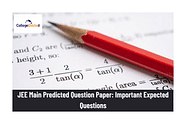
Time management is necessary to perform well in the CLAT Quantitative Techniques section. This section contains approximately 13 to 17 questions, and you need to attempt to complete it within 10 to 15 minutes in the two-hour test. Time management helps to avoid pressure and enhance accuracy. For this purpose, attempt easy questions to build confidence, avoid hard questions for the time being, and return later if time permits. Practising with CLAT mock tests regularly will help you improve speed and accuracy. Using these strategies will prepare you to deal with the Quantitative Techniques section in a calm and composed fashion, and you will be ahead on the day of the exam. A good preparation plan and time management are the secrets to achieving a good score in the CLAT 2026 Quantitative Techniques section.
Also Read: How to Prepare for CLAT 2026 Without Coaching?
Understanding CLAT 2026 Quantitative Techniques Section
When preparing for the Quantitative section, it is essential to learn the CLAT 2026 exam pattern and use your time productively. As of recent trends, this section will have approximately 13 to 17 questions, and you are provided with around 15 to 20 minutes to answer them. To achieve a good score, attempt to spend no more than 1 to 1.5 minutes per question. Good time management prevents you from being hung up on tough questions and missing the easier scoring ones.
Sections | MCQs per section | Maximum Marks | Approximate Weightage (in %) |
|---|---|---|---|
Quantitative Techniques (Elementary Mathematics up to Class 10) | 13 - 17 | 13 - 17 | 8.66 - 11.33 |
Effective Time Management Tips for CLAT Quantitative Section 2026
Here are some effective time management tips for solving questions in the CLAT 2026 Quantitative Techniques section:
#1 Prioritise Easy Questions First
Start with easy or familiar questions to build momentum and score early. To do that effectively:
- Use 3 to 4 minutes to quickly browse all questions.
- Mark and flag those which appear easy or you can definitely solve.
- Solve them immediately without much thinking.
- Leave tough questions for later.
- This approach provides confidence and prevents getting stuck, allowing for smoother navigation across the section.
#2 Skip Difficult Questions Initially
If you find it challenging or time-consuming, don't waste much time on it at first. Instead:
- Label the tough questions clearly so that they can be easily identified later.
- Move to the easier ones to score maximally.
- Return to the tough ones only if there is time left.
- Practice the tough ones to the extent of about two minutes in your initial round. The strategy keeps test-day anxiety at bay and eliminates last-minute scrabbles.
#3 Practice for Speed and Accuracy
Proper time management begins with daily scheduling:
- Practice quantitative problems from time to time in timed conditions.
- Monitor the time spent on each question and strive to decrease it regularly.
- Re-evaluate your errors to strengthen weak points.
- Practice previous year papers to know the types of questions that are often repeated.
- Practice full-length and sectional mocks to simulate exam conditions and maintain speed.
#4 Master Calculation Shortcuts
A majority of CLAT Quant questions are arithmetic, ratios, percentages, and data interpretation. Enhancing mental arithmetic skills can significantly conserve time:
- Master shortcut multiplication, percentage calculation, and ratio tricks.
- Take note of formulas like areas, volume, and averages.
- Master the fast reading of graphs and charts.
- These techniques speed up solving and enhance confidence in the exam.
#5 Review Answers Calmly
In case you have remaining time after answering questions, use it for reviewing:
- Take marked and calculation questions with special care.
- Verify complicated calculations for errors or mistakes.
- Check steadily rather than hurriedly.
Smarter time management in the CLAT Quant section allows you to solve questions correctly in larger numbers, stay calm, and boost your score. Through consistent practice and quick strategies like skipping lengthy problems initially, you can gain speed, accuracy, and confidence, giving a solid edge over competitors in CLAT 2026.
Related Reads:
Are you feeling lost and unsure about what career path to take after completing 12th standard?
Say goodbye to confusion and hello to a bright future!

FAQs
You should spend about 10 to 15 minutes on the CLAT Quantitative Techniques section during the exam. Focus on solving easier questions first to build confidence, then attempt tougher ones if time permits. Regular practice with mock tests will help you manage this time well and improve speed and accuracy for exam day.
To improve speed and accuracy in CLAT Quantitative Techniques, practice regularly with mock tests and past papers to get familiar with the exam pattern. Focus on mastering basics like arithmetic, ratios, and percentages. Use mental math tricks and shortcuts for quick calculations. Always analyse errors to avoid repeating them and manage your time wisely by solving easier questions first.
You should definitely attempt easier questions first in the CLAT Quant section. This helps build confidence and saves time for tougher questions later. Focus on accuracy and speed by solving the straightforward arithmetic and data interpretation problems initially. Skip lengthy or complex questions and come back if time allows. This strategy improves your overall score and time management.
Managing your time on the CLAT exam day for Quantitative Techniques is about planning and smart work. Aim to spend about 10 to 15 minutes on this section. Start with easier questions to build confidence, skip tough ones to avoid wasting time, and mark them for review if time permits. Practice mock tests to improve speed and accuracy. Always double-check your calculations calmly.
Here are common time-wasting mistakes to avoid in CLAT Quant:
- Starting to solve without reading the question fully, which causes errors.
- Spending too much time on tough questions instead of moving on.
- Ignoring unit conversions and key details in the question.
- Relying only on memorised formulas without understanding concepts.
- Not prioritising easier questions first to build confidence.
- Skipping regular revision and mock test practice.
- Overchecking or overthinking answers during the exam.
Was this article helpful?




















Similar Articles
CLAT GK on Environmental Conventions: Key Treaties and Agreements to Know
Last-Minute Mistakes in AIBE 20 Exam 2025 You Must Avoid
How to Use Bare Acts in AIBE 20 Exam 2025?
How to Crack CLAT 2026 Dual Passage Reasoning Questions
Key Environmental Reasoning Sets for CLAT 2026: Law Meets Logical Analysis
CLAT 2026 Application Form Link: Last Date (Nov 7), Steps to Apply, Documents Required, Application Fee